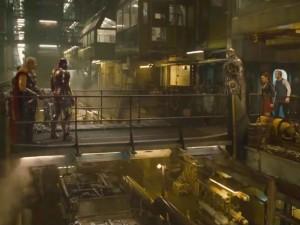
★★★★☆
In the past several years, the cinematic world has been overrun by movie after movie of superhero-villain standoffs and intricate computer-generated imagery. With just two or three companies dominating the market, the competition to produce the most successful superhero franchise has been overwhelming. “The Avengers: Age of Ultron” is a product of this environment, and while it may not bring any revelatory changes to the genre, it touches upon a particular infatuation that only Marvel seems able to satisfy.
The film picks up in medias res, following the team as they break into a Hydra (from the Captain America movies) facility. The Avengers are on a mission to regain Loki’s scepter (from the Thor movies), whose power source has unknown potential. Once it is in their possession, things quickly go awry. Tony Stark channels the staff’s power to create artificial intelligence for his robotic peacekeeping program, but the results are far from successful. Stark unwittingly releases the A.I. Ultron into the Internet, whose villainous plans to “save” the world by wiping out its entire human population once again force the Avengers into action.
Following the first installation of “The Avengers,” which became the third highest grossing film of all time, the sequel has been preempted with intense anticipation. While the antagonist Ultron’s eloquent madman voice nearly rivals contemporaries like Batman’s Bane, the overarching plot falls flat. One of the obvious drawbacks of having an Avengers sequel is that after the first combined movie, the individual superhero franchises continued to be produced separately, giving the sequel a disjointed feeling. This is especially disconcerting if viewers have not seen all of the many Marvel movies needed to fill in the backstory, and even if they have, it is hard to keep track of the terminology and connected plot points that weave in and out of each other.
The famous infinity stones, whose purpose is not yet quite clear, are temptingly dangled as a plot thread in the movie, but they do not play a central role in its progression. Instead of pushing all of the superheroes’ stories forward through this shared point, the movie adopts a short-term and hackneyed artificial-intelligence-gone-wrong dilemma, offering little in the way of character development.
The film is able to satisfy one’s craving for an epic assemblage of all of the Avengers, but it does not propel its characters past these temporary conflicts. The near monopoly Marvel has on the genre means that the company has the creative freedom to elaborate upon whatever plot points it wants in however many movies it sees fit to do so. It seems that the characters and infinity stones in “The Avengers” are working towards joining up with the cast of “Guardians of the Galaxy” at a snail’s pace – how long that will take is an issue in and of itself.
Particularly irksome are the depthless moments of intimacy between the cold, yet sultry Black Widow (Scarlet Johansson) and the awkward intellectual Bruce Banner (Mark Ruffalo). Without their own separate movie franchises to ground them, their character interactions come off as one-dimensional and frankly boring. Additionally, the audience is introduced to Hawkeye’s (Jeremy Renner) stereotypically perfect and loving wife and kids, whose parts are never fleshed out in very much detail.
Given the immensity of grouping together these superhero stories into one coherent narrative, it was somewhat expected that the film would feel choppy and rushed at times. Added to this muck was a copyright problem with the two newest characters, siblings Pietro (Aaron Taylor-Johnson) and Wanda (Elizabeth Olsen) Maximoff. Surprisingly, Disney handled the situation with tact and grace.
In the original comic books, the superhuman duo are called X-Men, the mutant offspring of the powerful Magneto. In 1993, the rights to those Marvel characters were licensed to 20th Century Fox, whose successful X-Men franchise has continued into the present. While Disney has the right to have the characters appear in “The Avengers,” it is not allowed to refer to the siblings’ past as mutants or their connection to their father in any capacity.
To solve the problem, “The Avengers” reworks the siblings to be “enhanced” individuals, whose superhuman powers originate from a voluntary scientific experiment that altered their genetic code. They are provided with a rich backstory about a near-death experience with a Stark missile, fueling their morally blurred motives and creating sympathy for their characters.
Regardless of the film’s less than stellar emotional depth and slow buildup for future sequels, it does do its job in delivering to audiences a glorious and unparalleled ride. The revolving camerawork and strategic use of slow motion coupled with the CGI make for a stunning action flick, and the first film’s signature moments of out-of-place humor come back in full force. With so many idiosyncratic characters to work with, all Marvel really had to do was throw them all together once again to have fans going wild.














